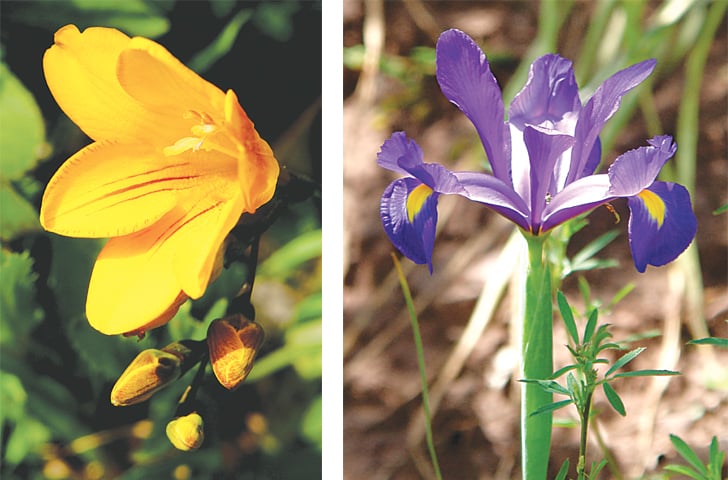
There is something sneakily special about bulbs and corms. Invariably, they surprise and delight when they decide, and in their own good time, to burst into life and start blooming. (If any of the characteristics that identify true bulbs are missing, the plant isn’t a true bulb. Instead, it’s a corm, tuber, tuberous root, or rhizome.)
The majority of bulbs and corms are planted beneath the earth, simply ticking away until daylight duration and weather conditions transmit to them that their time has come. And then they begin to grow, sometimes, if they have self-seeded as ‘freesias’ for instance often do, in the most unexpected of places.
Some gardeners find bulbs and corms a bit puzzling. After flowering time is over, they dig them up and store them in dry sand or whatever other medium is currently the acceptable norm, and then replant them. They are disappointed when exactly the same number, perhaps less, decide to show their faces, producing far less flowers than in the year before. This, however, is entirely natural as a badly-disturbed natural cycle causes the bulbs and corms to show their displeasure.
Nutrients stored in bulbs and corms during one growing season will help in the production of roots, leaves, and flowers for the next season
What simply happens is that when you purchase bulbs and corms, they are usually about one to two years old from seed, and have just enough stored energy to produce the expected flowers, and they almost completely drain their strength in doing so. If they are dug up and stored as soon as flowering is over, they have not had any time to replace the energy necessary for them to flower again, let alone multiply.
If you want your bulbs to thrive and multiply, they must be left in the earth to do as nature intended, i.e. to survive and multiply in the years to come.
Encouraging bulbs and corms to survive in our fickle climate is not an easy matter but it can be done, as long as great care is taken in selecting suitable planting locations, with suitable soil and drainage, for the individual species concerned.

Don’t dig bulbs and corms up — unless it is to divide them up when they become overcrowded — just leave them be.
Here are some of the bulbs and corms you may enjoy growing in your garden and, with planting time from the middle of this month on through to the middle or even the end of December, you have lots of time to make your selection. Narcissus (Nargis) and daffodils, in all of their various sizes and forms, jewel-bright tulips, incredibly perfumed Dutch hyacinths, deep blue grape hyacinths, glowing crocus, pretty sparaxis, gorgeous freesias, rannunculous in myriad dazzling hues, Dutch iris, miniature iris, Asiatic and Oriental lilies, anemones, amaryllis, rain lilies, tuberoses by the score and perhaps some begonias too.
Seeds to sow this month include the following:
In the vegetable garden: Broccoli, calabrese — with its intriguing, spiral-shaped, green heads — various winter and spring cabbage and cauliflower varieties, green onions, beetroot, carrots, turnips, rutabaga, red Russian and black Italian kale, curly kale, spinach, lettuce, raddichio, endive, chicory, mustard, giant red mustard, mustard greens, mustard mizuna, bush beans, climbing beans, broad beans, peas, sugar peas, onions, celery, French radish, Chinese, Russian and Spanish winter radish and, in the plains and coastal regions, tomatoes although they will need protection from winter cold.

Potatoes and garlic can be planted this month as well.
The herb garden: Coriander, zeera (cumin), aniseed, dill, chamomile, oregano, thyme, lemon balm, chives, garlic chives, Welsh onions, rosemary, quick maturing types of lavender, flat leaf and curly parsley, sage, fennel, water cress, cress, borage, comfrey, lovage and all kinds of mint including green mint, peppermint, lemon mint, apple mint and pineapple mint, plus those well known favourites, nasturtiums and calendulas.
In the flower garden: Wallflowers, violas and pansies, honeywort, geraniums and pelargoniums, bellis, sweet Williams, carnations, pinks, sweet sultan, cornflowers, larkspur, petunias, antirrhinums — be they dwarf, medium, tall or absolutely gigantic — lobelia, candytuft, godetia, nigella, allysum, ageratum, nigella, verbena, coreopsis, annual chrysanthemums and, after the middle of the month, a start can be made on sowing sweet peas and lots and lots of annual varieties of poppies.

Flower of the month: Narcissus is one of the most loved flowers in the country.Nargis is indigenous in our northern areas and wildly grown everywhere else. Locally produced Nargis bulbs, along with numerous imported hybrids, should be available in garden supply stores now and will continue to be available throughout their planting season, which finishes during the last half of December. Nargis do best in dappled shade, growing equally well directly in suitable garden soil — this must be of reasonable quality and well-drained — and in pots/containers of medium-grade, good-draining, preferably organic, compost. In the garden, plant Nargis bulbs about four inches apart — less if they are a miniature variety — with their pointed tops from which growth emerges, approximately two inches beneath the soil surface (one inch for miniatures). They can be planted the same way in pots/containers or, for quicker flowering, can be planted with the tip of the bulb/s exposed. The latter method is particularly popular when planting bulbs that have been specially treated to produce out-of-season blooms. Keep soil/compost lightly moist and the bulbs will grow to produce their gloriously fragrant flowers during early to mid-spring, sooner if they have been treated. There are more than 12,000 hybrid varieties of Nargis all around the world now: single, double, frilly, pleated, bi-coloured and in many sizes, but the indigenous Nargis of Pakistan will always rule the roost.
Please continue sending your gardening queries to zahrahnasir@hotmail.com. Remember to include your location. The writer does not respond directly by email. Emails with attachments will not be opened.
Published in Dawn, EOS, October 7th, 2018














































